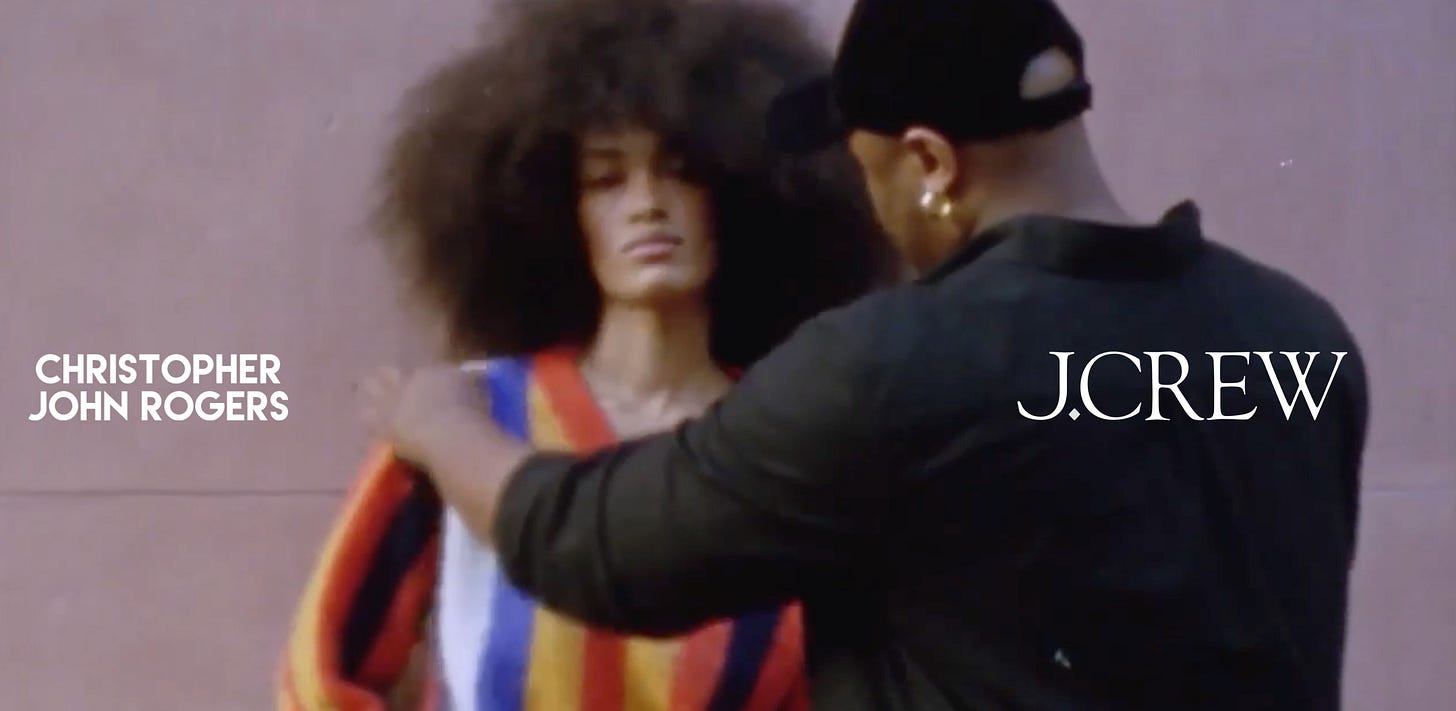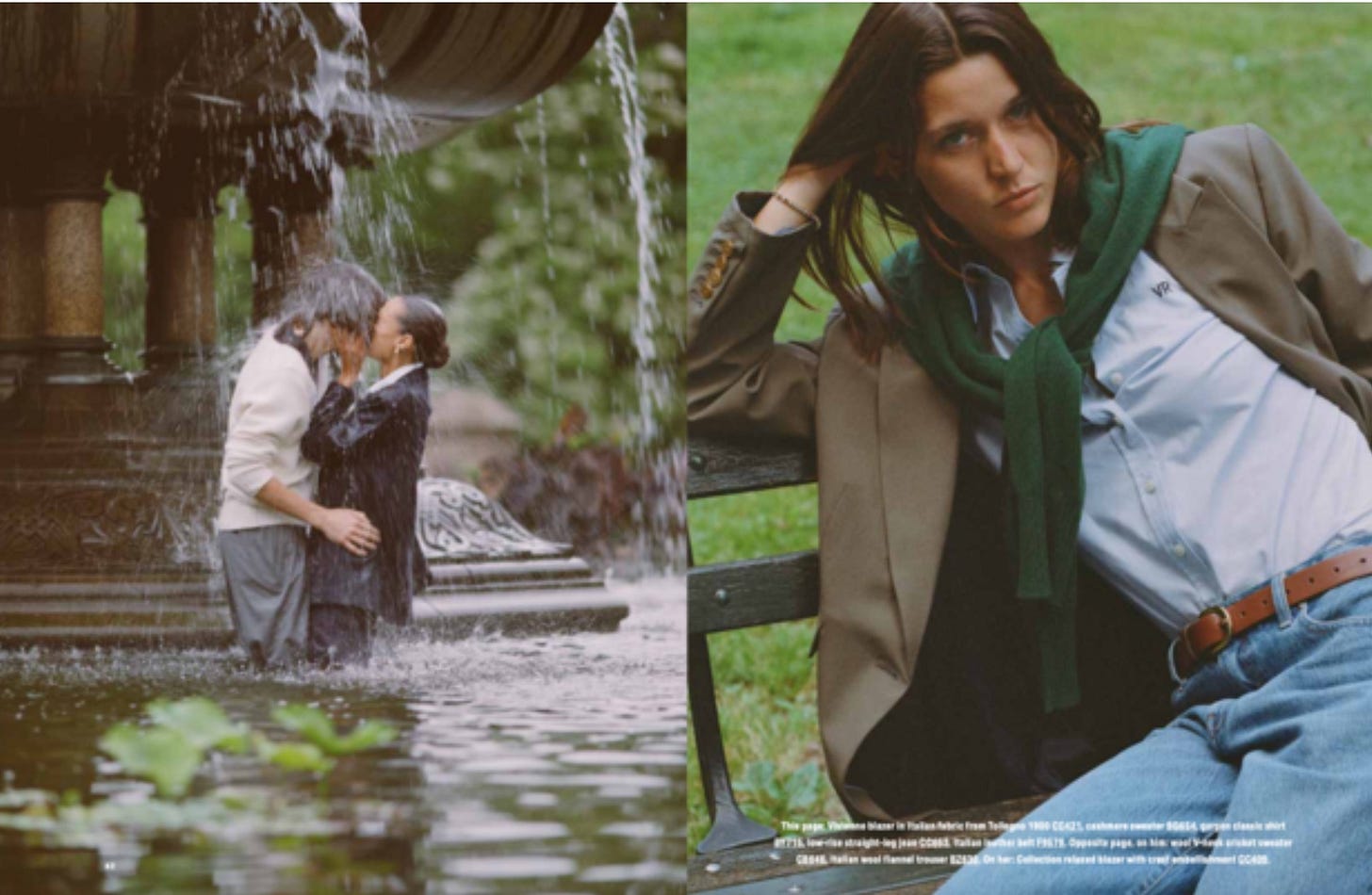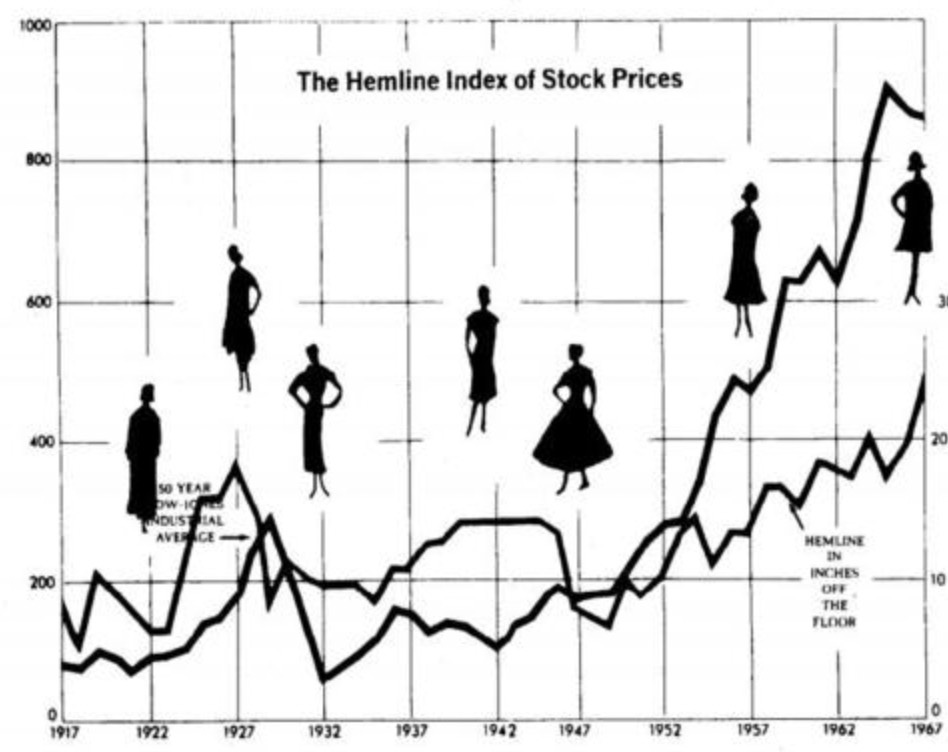J.Crew's New Americana: The Intersection of Fashion, Politics, and the Economy
TikTok fashion trend analysts are calling red the color of the season, and it seems that red isn't just dominating our wardrobes—it’s also bleeding into our politics. Let's Digest!
Lately, I’ve noticed a cultural shift in fashion that suggests we’re seeing more than just changes in personal style or seasonal trends. I’m referring to the rise of the “Clean Girl Aesthetic” and the shift from the sneakerhead culture that defined the late 2010s and early 2020s to a growing love for ballet flats. Primarily annotated by the comeback of America’s sweetheart… J.Crew
Could these shifts connect to a larger societal and political story?
Let’s Digest!
In the aftermath of the 2024 election, the contrasts between 2020 and 2024 are stark—not just in politics but in broader cultural and fashion landscapes. While 2020 was marked by progressive activism, non-binary fashion influences, and bold, statement-making styles, the current era leans toward a quieter, more conservative ethos. And no brand better embodies this shift than J.Crew. Once on the brink of collapse, this American fashion stalwart has made an extraordinary comeback, reflecting deeper societal currents.
In 2020, J.Crew filed for bankruptcy, a symbol of the tumultuous period brought on by the pandemic, economic lockdowns, and shifting consumer priorities. At the time, fast fashion dominated, with consumers gravitating toward trend-driven, low-cost options. The brand, known for its classic, preppy aesthetic, seemed like a relic of a bygone era. Yet, just four years later, J.Crew stands as a case study in cultural and political alignment, having reinvented itself while staying rooted in its core identity.
The resurgence of J.Crew aligns with larger social trends. The political climate leading to Joe Biden’s 2020 victory was charged with progressive movements: women’s rights marches, Black Lives Matter protests, non-binary street style, and a prevailing wave of progressive ideals. Fast forward to today, and there seems to be a noticeable shift in the cultural and political landscape. The buzz around non-binary fashion has quieted, sneakerhead culture is on the decline, and in its place, we see more emphasis on gendered dressing—think more bows, dresses, and a return to modest, conservative styles. What does this say about the 2024 political zeitgeist? This evolution echoes the rise of conservative politics, such as the overturning of Roe v. Wade and policies like Project 2025, which have influenced cultural values and, in turn, fashion preferences. It’s easy to see that conservatism—particularly among younger generations—is on the rise. In fact, it seems the “silent majority” is making its presence felt, and this whispers through subtle, yet powerful, shifts in fashion.
As a victim of the “Sneaker Head to Ballet Flat Pipeline”, I see two main trends emerging: the return of gendered fashion, and a move toward more modest looks. The second identifies the shift from form-fitting, provocative, or dare I say Liberal styles to modest Conservative ones. Yes, it seems that between 2020 and 2024 both fashion and political ideology have shifted slightly more Conservative than Liberal.
This shift isn’t just political or economic—it’s cultural. Fashion, like politics, is cyclical, and J.Crew has positioned itself at the forefront of this new cycle. J.Crew’s emphasis on quality and timelessness fits this narrative. As consumers tire of fleeting trends and low-quality fast fashion, they’re investing in versatile, durable pieces that transcend seasons.
But what caused these shifts in the first place? How did the progressive, non-binary street style of 2020 give way to ballet flats and button-ups? And what role do globalization, media, and economic policy play in shaping these trends?
To venture towards an answer, I will start by identifying shifts in culture and follow by analyzing J.Crew’s perceived strategy.
The cultural shift in fashion could be for a plethora of reasons, for today's purposes I will focus on the consumption cycle as it relates to fashion, content, economics, and politics. When discussing the consumption of content or information, the popularity of aesthetics like the “Clean Girl”, “Old Money”, and “Trad Wife” influence how people present themselves. These nods to traditional, often modest fashion, are having a major cultural impact. This is also apparent in the increased affinity for vintage second-hand fashion and its influence on the styles brands produce. On the runway, during fashion month many brands showcased collections that were inspired by their 1960’s and 70’s archives, which were inherently more modest. Lampoon Magazine discusses Chemena Kawali's debut show for Chloé with the following, “The collection she presented takes inspiration from the 1970’s, when Karl Lagerfeld was at the helm of the brand. Platform wedge heels, ruffles en-masse, dramatic capes; the collection is influenced by the 70’s bohemian rock n’ roll and is a celebration of feminine power dressing”.
Whether it’s runway fashion or social media trends, the overarching movement seems to favor the consumption of conservative aesthetics. This could also be a result of personal preference, not necessarily the preference to “cover the assets” but to look at clothing as an asset. Thus, consumers may be looking for clothing that is more versatile and of higher quality, many of these styles lean modest. As evidenced by the “comeback” of our focal point J.Crew and even Zara—whose offerings are perceived as more durable and refined compared to brands like Fashion Nova or Pretty Little Thing, known for their more provocative, fast-fashion styles.
While the analytics of these four companies may not have shifted much, observationally the latter of the bunch have increased in social relevance as of late. This case study is most applicable to J.Crew, who filed for bankruptcy in 2020. Since then J.Crew has applied the playbook for staying relevant in the twenty-twenties, this playbook is built on the foundation of winning over younger consumers to turn them into brand loyalists. A major component of this is banking on brand collaborations and nostalgia marketing.
In the fall of 2024, J.Crew unveiled a game-changing collaboration with New York-based fashion icon Christopher John Rogers, blending his vibrant, colorful aesthetic with the brand’s signature preppy, timeless style.
This partnership is a key move in J.Crew’s reinvention, helping to position the brand for a new era while staying rooted in its American heritage. It’s like giving your childhood bedroom a modern makeover—still familiar, but with an exciting new twist. And just like that childhood room, J.Crew is that comforting, nostalgic home base, with its quality and classic designs echoing the sweaters your mom’s had since middle school. This cozy familiarity is exactly what propels J.Crew’s successful nostalgia marketing, tapping into something we all share: memory. This ode to familiarity takes us to the second page of the “relevance playbook”. This page is J.Crew’s successful nostalgia marketing. While many people differ on beliefs, one area of similarity is nostalgia, many of us remember the J.Crew catalog days. Many of us remember flipping through the J.Crew catalog as kids, circling our Christmas wish list items, and imagining our dream wardrobe. Sure, most of what we picked never made it under the tree, but for me the act of choosing what I liked shaped my fashion identity more than the things my mom actually bought. That nostalgia—whether we realize it or not—keeps us coming back to the brand. It’s not just about the clothes; it’s about a lifestyle, a cultural touchstone. In 2024, WeddingTok influencers were turning to old and new J.Crew catalogs as their creative guides for photoshoots, proving that the brand’s identity goes far beyond a simple transaction. It’s a symbol of Americana, the kind of clothing that says something about who we are, where we come from, and how we want to be seen.
Personally, I dream of the day I can recreate this style of photo shoot.
But J.Crew isn’t just indulging in nostalgia for nostalgia’s sake. Their 40th-anniversary catalog re-edition wasn’t just about celebrating the past—it was about reimagining the idea of Modern American Life. This shift brings us to the bigger picture: the role of digital globalization and marketing in shaping consumer culture. For most of four decades, J.Crew dominated the American fashion scene. But as global brands like Zara and H&M began making their mark, the competitive landscape shifted, forcing J.Crew to rethink how it communicates with consumers. Zara made its U.S. debut in 1989 and now boasts 100 storefronts across the country as of 2024, showing just how far the global fashion juggernaut has come. Competing with these international powerhouses requires not just innovative designs but a global marketing strategy, which is why we’ve seen the shift from J.Crew’s traditional, physical catalogs to sleek digital e-blasts and social media blitzes. But here’s where it gets interesting: the re-release of J.Crew’s iconic catalog feels like a subtle nod to a larger cultural shift—America First. Now, before you roll your eyes, let’s break this down. Post-bankruptcy, J.Crew made a bold move by closing all six of its UK stores, a sign that the brand is leaning into a distinctly domestic focus. The Trump administration’s "America First" policies seem to have become sewn into fashion pre-inauguration —whether we like it or not. “America First” carries a heavy history and, while it’s now often associated with conservative rhetoric, its original intent has been politicized in complex ways over time. While on the surface the phrase seems like it should be universally accepted by Americans, it has been used to fuel radical groups that are unaccepting of many Americans. Beyond the divisive political connotations, though, in the fashion world, it signals something a little simpler: J.Crew is putting its chips on winning over U.S. consumers in the face of fierce global competition from brands like Zara and H&M. These international powerhouses may have the price point advantage, but J.Crew is banking on nostalgia and cultural capital. By revisiting their archives, J.Crew is evoking that pre-globalization, all-American aesthetic that Zara just can’t replicate, no matter how many stores it opens in the U.S. This cultural play is tied closely to the idea of perceived quality. J.Crew isn’t shy about the fact that their clothes come with a higher price tag. But they back it up. On their “Our Story” page, the brand proudly touts their commitment to timelessness and the integrity of well-made clothes, stating: "Great quality at a great price." In contrast, Zara’s brand ethos is less about quality and more about scale, relying on their massive international presence to sell their fast-fashion philosophy. The difference here isn’t just about price—it’s about the emotional value that J.Crew offers.
While much of J.Crew’s revival can be credited to the strategic vision of Creative Director Olympia Gayot (since 2020), it’s also about tapping into the growing desire for investment in quality clothing. After years of rapid trend cycles powered by brands like Shein, Pretty Little Thing, and BooHoo—where we’ve all stocked our closets with fleeting, low-cost, one-season pieces—the pendulum is swinging back. Consumers are tired of having their closets filled with "ghosts" of trends past, clothes that are no longer versatile enough to justify their cost-per-wear or that fall apart after a few washes. The shift? People are ready to spend more on timeless, durable, and versatile pieces—clothes that will last, no matter the trend. J.Crew is seizing this moment with its "modern" take on American style, and in doing so, is emerging as a surprisingly relevant player in today’s fashion landscape. They’ve managed to capitalize on the societal shifts brought about by post-2020 work-from-home policies, shifting back toward corporate couture as office mandates bring back business attire. As people start dressing for a more office-centric world again, conservative aesthetics—both in style and function—are starting to dominate. As a result, the once-booming fast-fashion market is being tempered by consumers’ desire for clothes that blend classic looks with practical wearability. In this new world, J. Crew isn’t just tapping into nostalgia—it’s betting on a return to a quieter, more sustainable form of consumption. The once-cool streetwear styles are now competing with smart, polished looks that say, "I’m here for the long haul" not to post a Shein Haul. In essence, the changes happening in the fashion world reflect more than just trends—they’re a direct response to how the political and economic landscape has shifted. J.Crew’s pivot shows that, sometimes, fashion is more than just about what we wear—it’s a mirror to the broader changes in society.
When we talk about fashion and politics, it’s impossible to ignore how one often reflects the other. Take the Trump presidency, for example, which has proposed tariffs on imported goods, particularly from China. These tariffs are poised to have a major impact on pricing in the fashion industry, and with my degree in economics, I can tell you that the ripple effects will be felt by consumers. With the U.S. outsourcing about 97% of its clothing production, these "America First" policies could send the fashion industry into a tailspin. What does that mean for the average shopper? Well, brace yourself for rising prices, and as costs climb, consumers are likely to prioritize versatility over trends—think longer skirts and less skin.
This shift in fashion isn’t just a matter of personal taste—it’s deeply connected to the broader economic landscape. J.Crew’s revival also reflects broader economic patterns. Historically, fashion trends align with financial conditions—a phenomenon famously captured by the “Hemline Index”. Developed by economist George Taylor in the 1920s, this theory suggests that skirt lengths mirror economic confidence. When the stock market is doing well, skirts get shorter, signaling prosperity and optimism. Conversely, during periods of economic uncertainty or recession, hemlines lengthen, reflecting caution and modesty.
This insight connects directly to J.Crew’s current aesthetic. In uncertain times, modesty prevails, and J.Crew’s classic, refined designs align perfectly with a consumer base seeking stability and practicality. The brand’s pivot toward timeless, versatile clothing reflects a society navigating financial and political turbulence.
It’s a fascinating link between fashion and the economy that suggests our clothing choices aren’t just about aesthetics—they’re a response to the political and financial environment we live in. So, as we see fashion leaning toward more modest, practical designs, it's not just a coincidence; it's the economy, and the politics, at work.
Fashion reflects the shifting tides of society, mirroring political, economic, and cultural movements. J.Crew’s transformation is more than a branding success; it embodies a societal pivot toward conservatism, economic caution, and nostalgia for stability. The resurgence of timeless, modest styles tells a story of a world grappling with uncertainty, where what we wear becomes a silent language of adaptation and aspiration. In times of upheaval or progress, our wardrobe choices become a silent yet powerful language, expressing solidarity, dissent, or aspiration. From the rise of conservative aesthetics in fashion to the economic forces that shape what we wear, the clothes we choose are more than just fabric—they are a direct response to the world around us. As we navigate political shifts and economic uncertainties, fashion remains a mirror of our society’s values, anxieties, and desires. Whether it’s the shift toward timeless, versatile pieces or the nostalgic embrace of an "Americana” ethos, the clothes we wear tell a story about who we are and where we’re headed. As history has shown, fashion is never just about what’s on the surface—it’s a reflection of the deeper currents of culture and politics that shape our world. And as these forces continue to evolve, so too will the trends we follow, stitched together by the fabric of the times.
But what sparked this shift? How did the progressive streetwear of 2020 give way to ballet flats and button-ups? What roles do globalization, media, and economic policy play in shaping these trends?
Fashion is never just fabric—it’s a reflection of deeper currents shaping our world. Stay tuned for Part 2, where we’ll uncover the forces driving these changes and their broader implications.
Thank you for consuming.
Thank you for consuming,
Phia
“Each Day Gets Better”
Links and Sources
https://lampoonmagazine.com/article/2024/03/05/paris-fashion-week-conservatism-old-money-aesthetics-mob-wife-and-clean-girl/
https://www.usatoday.com/story/news/politics/elections/2024/11/11/what-are-tariffs-trump/76195638007/
https://www.eur.nl/en/media/2020-11-hemline-and-economy-there-any-match#:~:text=In%201926%20an%20economist%20called,prices%20or%20gross%20domestic%20product
https://english.elpais.com/economy-and-business/2024-09-20/inditex-owner-of-zara-stores-is-planning-ambitious-expansion-in-the-us.html#:~:text=Inditex%20landed%20in%20the%20United,market%2C%20only%20behind%20Spain%20itself
https://www.theguardian.com/fashion/2020/sep/21/j-crew-to-close-all-six-of-its-uk-stores-fashion-us-retailer
This is Phia’s Substack.








